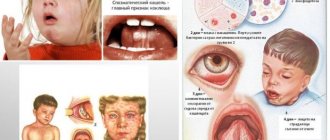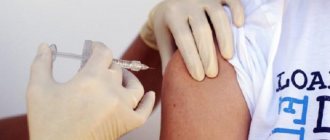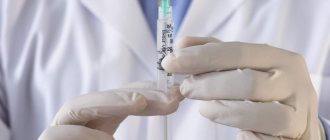What do PSCHI and PSS vaccines contain?
PSCHI is a vaccine containing specific antitetanus antibodies (100 IU of active substance is contained in 1 ml). Additional components of the drug are represented by glycine, which acts as a stabilizer, water for injection and sodium chloride.
PSS (tetanus serum) is a protein fraction of horse blood serum that has been immunized with tetanus toxoid or toxin. It contains immunoglobulins. Also contains chloroform. The serum is available in the form of a clear or yellow-tinged liquid.
Mechanism of action
Tetanus is one of the most dangerous infectious diseases - the mortality rate for children is about 90%; for adults, this figure ranges from 20 to 80%. Therefore, the easiest way to protect a person from the disease is vaccination. The vaccine contains weakened tetanus (if the vaccine is complex, then diphtheria) toxins.
These toxins retain their immunogenic properties, so once introduced into the body, they trigger an immune response to their presence in the form of the production of specific antibodies. The body remembers the structure of this antigen and, in case of illness, the produced antibodies recognize the pathogen and help actively fight it. Thus, the body develops acquired immunity.
It, in turn, is divided into natural and artificial acquired types. With natural immunity, antibodies are synthesized by the body independently after suffering from illness. The body acquires passive immunity through the introduction of antigens against various diseases artificially - that is, vaccination.
After the vaccine is administered, the maximum concentration of antibodies in the blood is achieved within 1-2 days. The elimination period from the body ranges from 6 to 8 weeks.
Frequently used method
A common method is a desensitization method that is necessarily used to prevent anaphylactic reactions (see Anaphylaxis) when injecting antibacterial and antitoxic therapeutic and prophylactic serums: first 0.1-0.3 ml of serum is administered subcutaneously, and after 1-2 hours the remaining dose.
Bezredka methods (A. M. Bezredka) are methods of desensitization, oral vaccination, immunization with live sensitized vaccines, which have found application in the specific prevention and therapy of infectious diseases.
The most common of them is the desensitization method used to prevent anaphylactic reactions (see Anaphylaxis) when antitoxic, antibacterial or antiviral heterogeneous sera (obtained from a horse or other animal) are administered for prophylactic or therapeutic purposes. Repeated administration of such serum can cause serum sickness (see) or anaphylactic shock. Desensitization according to Bezredka is also necessary when introducing into the body a therapeutic serum purified by various methods from ballast substances. It is known that individuals with hypersensitivity to protein fractions of antitoxic serums (antidiphtheria, antitetanus, etc.) react to their administration with severe symptoms of shock. When desensitization according to Bezredka, a small amount (0.1 ml) of serum is first administered subcutaneously, and then after 1-2 hours the remaining dose is administered.
The second of Bezredka’s methods, the oral vaccination method, is used against intestinal infections and is based on Bezredka’s concept of so-called local immunity (see Immunity). According to Bezredka, immunity during oral immunization against intestinal infections is acquired due to immunization of a sensitive tissue or organ (for example, the intestines in dysentery) and the natural resistance of other tissues and organs. For oral immunization against intestinal infections, Bezredka proposed a dry vaccine in the form of tablets (three days in a row, 1 tablet containing 100 billion killed microbes). For better absorption of the antigen, the intestines were sensitized with ox bile. The method is not widely used.
The third method proposed by Bezredka is active immunization against typhoid and dysentery with live vaccines sensitized with specific immune serum. However, these vaccines have not been tested in wide epidemiological experience and have not become widespread in the practice of preventive vaccinations against typhoid fever. See also Immunization.
Indications for vaccination
The drug is used in 2 main cases:
- For the prevention of disease (including emergency).
- For the treatment of tetanus/diphtheria.
Emergency prevention is carried out in case of various injuries (industrial, domestic injuries, frostbite, insect bites, penetrating injuries, splinters, bedsores, etc.), when the causative agent of infection (tetanus bacillus) can enter the body through an open wound.
The main habitat of this microorganism is the soil, where it can remain active for several years. Routine vaccination is carried out according to the established vaccination calendar.
Timing of vaccine administration
The administration of serum according to Bezredko to persons who have been injured must be carried out as soon as possible - within 20 days (if patients were vaccinated against tetanus more than 5 years ago). It is during this period, if the pathogen enters the body, the disease can occur in a latent form - without the manifestation of corresponding symptoms.
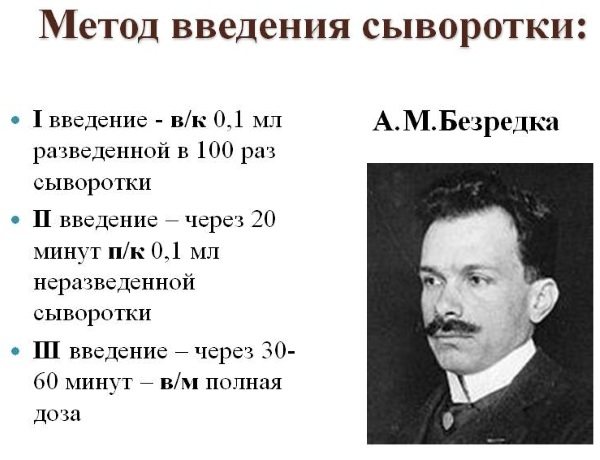
If a person has not previously been vaccinated against tetanus/diphtheria or he does not have a full course of scheduled vaccinations, in addition to the vaccine, he is given a special serum. It helps in a short period to create and develop the body specific immunity to the pathogen.
Detailed description of the study
Platelets are nuclear-free blood cells, blood platelets. They are formed in the red bone marrow and remain viable for 7-10 days. Platelets have properties such as adhesion (the ability to stick to the vascular wall) and aggregation (the ability to stick together). These properties ensure the implementation of the main functions of platelets: hemostatic and angiotrophic. Platelets also contain some active substances and coagulation factors, which, when activated, are released into the blood.
The hemostatic function of platelets is the secretion of vasoconstrictor substances, the formation of a platelet plug when the integrity of blood vessels is disrupted, and the acceleration of the formation of a fibrin clot.
The angiotrophic function is that platelets supply growth factors for the cells of the vascular wall, necessary for its restoration. Therefore, thrombocytopenia is often accompanied by the appearance of pinpoint hemorrhages in the skin or mucous membranes. In addition, platelets perform a protective function by “gluing” (agglutination) bacteria. Marked changes in the number of platelets in the blood can lead to various pathological processes: blood clotting disorders (thrombosis or bleeding), vascular fragility (the appearance of bruises and petechiae), and a decrease in the body’s protective properties. Sometimes counting platelets in a complete blood count can be difficult. This is observed with a pronounced tendency of platelets to aggregation, with certain diseases, as well as with exposure to toxic substances.
In such cases, platelet count according to Fonio is recommended. The advantage of this method is that the platelet count is calculated per thousand red blood cells in stained blood smears. Then the resulting amount is recalculated in proportion to a certain volume using a special formula.
How is vaccination tolerated?
Vaccination against tetanus and diphtheria is usually easily tolerated - without a significant deterioration in well-being. Often vaccination is done with a complex preparation that contains several antibodies at once. For example, vaccination against whooping cough, diphtheria and tetanus (DPT) or tetanus and diphtheria (DT).
This vaccine is more likely to cause adverse reactions because it is multicomponent. To avoid deterioration of health after vaccination, it is recommended to do so within 30 minutes. stay in the hospital - if unpleasant symptoms develop, doctors will provide the necessary assistance.
Possible reactions and complications
The body's reaction to the introduction of a vaccine can be of 2 types:
- Post-vaccination reaction (develops immediately or within a few hours after the vaccine is administered and goes away on its own approximately 3 days after vaccination).
- Post-vaccination complication (causes changes in the body and deterioration in health, which are long-term; therapy may be required).
Types of reactions and possible complications to vaccination are presented in the table below:
| Body reaction | Symptoms | Frequency of occurrence |
| Local reaction | Swelling, pain, redness and swelling at the injection site. | From 25 to 80%. |
| Systemic reactions | Increased body temperature. | About 10% of cases. |
| Weakness of the body, irritation. | Up to 25% of the total cases of vaccinated people. | |
| Complications | Brain damage. | 1 case in 300 thousand (for complex vaccination with whooping cough). |
| Severe allergic reactions. | 1 case per 100 vaccinated. |
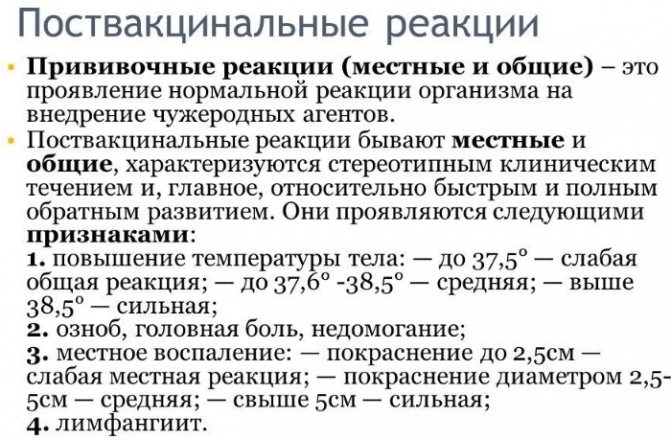
When vaccinated in childhood, children may complain of pain while walking, itching at the injection site. In adulthood, the incidence of reactions to vaccination decreases.
It is worth noting that the risk of possible complications after vaccination is hundreds, and in some cases, thousands of times less than the risk of developing complications after an infectious disease.
Prevention of anaphylactic shock (Bezredki method)
Symptoms of anaphylactic shock.
Anaphylaxis.
Permissive dose.
Sensitizing dose.
Anaphylaxis.
One form of altered reactivity is anaphylaxis.
Richet's experiments in 1902 showed that a change in the reactive state of the body is possible, expressed in its sharply increased sensitivity to repeated administration of the same foreign protein substance. Richet called this condition anaphylaxis , which means “opposite to defense” (from the Greek ana - I deny and fylaxo - I protect).
To better understand the topic, let's get acquainted with the terms:
The initial introduction of an antigen (protein), causing increased sensitivity of the body. It lasts for many years.
A repeated dose of an allergen (protein) causing the development of anaphylaxis.
Increased sensitivity of the body to repeated introduction of foreign protein.
4.Histamine is a biological active substance that causes the development of a pathological process.
Carefully study the “Mechanism of shock formation” according to scheme No. 2
Clarification.
The development of anaphylaxis includes three periods:
1. Preparatory period - after the initial introduction of a foreign protein, the reactivity of the body changes.
2. Incubation period – a state of sensitization develops, the duration of the period is 10-12 days.
3. Resolution period – the occurrence of anaphylactic shock due to the secondary introduction of a foreign protein.
Anaphylaxis can only be performed in sensitized animals.
With the development of anaphylactic shock, various organs and tissues are affected:
CVS – decreased blood pressure, thready pulse, pallor, cold sticky sweat.
Respiratory system – shortness of breath, suffocation.
Nervous system – severe headache, dizziness, loss of consciousness, convulsions.
Excretory system – involuntary urination.
Digestive system – cramping abdominal pain, vomiting, involuntary defecation.
Thermoregulation – lowering body temperature.
Removing a living organism (animal, human) from a state of sensitization is called desensitization.
A.M. Bezredka showed the great importance of the central nervous system (CNS) in the development of anaphylactic shock and that it can be prevented if the animal is given a permissive dose under anesthesia. He also showed that if a very small amount of antigen (serum) is administered to a sensitized animal before the end of the incubation period, then desensitization occurs . The animal becomes resistant to subsequent administration of the antigen and anaphylactic shock does not develop. This principle of desensitization is used in medical practice to prevent the development of anaphylactic shock.
This is interesting.
About 1% of the population has allergic reactions to insect venom (bees, wasps). For desensitization, pure wasp venom is obtained. From 74 million wasps you can get 500g. poison that is enough to desensitize 350 thousand people for a year.
Attention!
Method A.M. Non-redundant – fractional injection of antigen (serum).
Fractionally administered small doses of antigen (serum) bind antibodies circulating in the blood and thereby prevent the formation of high concentrations of histamine,
causing anaphylactic shock.
To prevent anaphylactic shock:
· preliminarily perform an intradermal test (flexor surface of the forearm) – 0.1 ml. serum diluted 1:100. After 20 minutes a papule appears. If the reaction is negative, then the diameter of the papule is no more than 0.9 cm. This means that this serum can be administered further.
· 0.1 ml. serum is administered subcutaneously . After 30-40 minutes, desensitization occurs.
· administer the remaining dose (according to instructions).
Technique for introducing serum using the Bezredko method
Frequently, a French microbiologist who proposed a method of administering therapeutic serums based on reducing or preventing the body’s negative reaction and the development of complications to them (in particular, in the form of anaphylactic shock). This method involves fractional administration of drugs.
This makes it possible to neutralize antibodies and reduce the concentration of active substances in the blood, as a result of which subsequent administration of antigens does not cause the development of complications.
The introduction of serum according to Bezredko has a specific algorithm:
- The ampoule with the drug must be carefully examined. If the liquid contains sediment, cloudiness, foreign impurities, the ampoule is damaged, or the label with the necessary information is missing, the use of such medication is prohibited.
- Before opening, the end of the ampoule must be treated with sterile cotton wool. After opening, the ampoule should be covered with a sterile napkin.
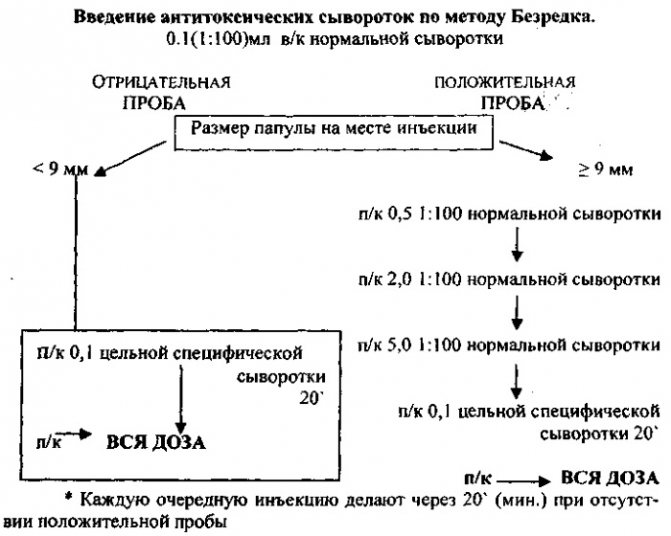
Algorithm for serum administration according to Bezredko - Before administering a therapeutic dose, it is necessary to test the body's sensitivity to the drug through a test. For this, a special diluted serum is used (comes with the drug and is marked in red). The sample is injected subcutaneously into the arm above the wrist, having previously disinfected the future injection site. The drug is administered with a special tuberculin syringe with a thin needle. As soon as the cut of the needle enters the skin, 0.1 ml of diluted serum is injected. If after 20-30 minutes. the diameter of the papule formed as a result of the injection is less than 0.9 cm, and there is slight redness around it; the test is considered negative.
- After this, 0.1 ml of undiluted serum should be injected subcutaneously into the outer surface of the shoulder.
- After half an hour from the moment of injection (if there is no reaction to repeated administration of the drug), the remaining prescribed dose is administered intramuscularly.
The Bezredko method underlies the introduction of most serums used to treat and prevent the development of various diseases.
Antitetanus serum
The serum is administered according to the above algorithm. The dosage of the drug during treatment is 1500-2000 IU for each kg of a person’s weight. Such a high dose allows the tetanotoxin to quickly bind, which, after infection of the body, spreads into the lymph, blood and cerebrospinal fluid of a person, provoking muscle spasms.
If a severe course of the disease is observed, the following serum administration scheme is allowed:
- Intramuscularly - 100 thousand IU is injected (injected into the gluteal muscle or under the shoulder blade).
- Intravenously - up to 50,000 IU. In this case, the indicated dosage is diluted with an isotonic solution of sodium chloride (the ratio is from 1:5 to 1:10) and heated to a temperature of 37 0C.
When the indicated doses are administered, antitoxic antibodies are produced in the body over a period of 3 weeks, so repeated administration of the serum is not required. Additionally, the patient is prescribed a course of antibiotics. If necessary, anti-shock measures can be taken - warming, the use of stimulants of the cardiovascular and nervous systems, blood transfusions, etc.
If the test for sensitivity to anti-tetanus serum shows a positive result, then its administration can be carried out only if there are clear indications (for example, extensive contamination of the wound).
For botulism
The administration of serum according to Bezredko for botulism is carried out according to the general scheme with a mandatory test for sensitivity to the drug. The injection is prescribed immediately after the clinical diagnosis is established, since it has the maximum therapeutic effect in the first 72 hours from the onset of the disease.
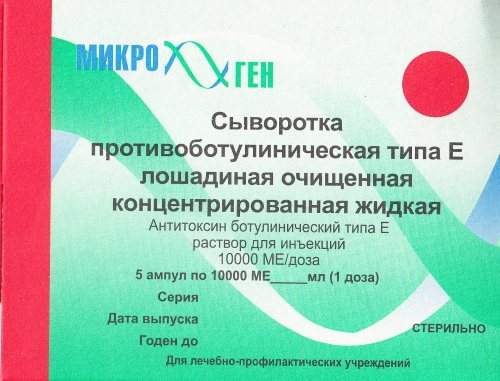
The dosage of a drug containing horse antitoxin depends on the type of disease the person has. For example, with serotype B, 15-20 thousand IU must be administered.
If the type is unknown, then a complex of single-component drugs or polyvalent serum is administered according to the following scheme:
- 10,000 IU antitoxin type A;
- 10,000 IU type E antitoxin;
- 15-20 thousand IU of type B antitoxin.
RULE FOR ADMINISTRATION OF PSS USING THE BEZREDKE METHOD
1. Inject 0.1 ml of diluted (1:100) PSS intravenously into the middle third of the inner (flexor) surface of the forearm.
open the ampoule with red markings;
dial 0.2 ml;
release the air from the syringe and needle.
2. After 30 minutes, evaluate the reaction to the intravenous test: in the presence of hyperemia, papules with a diameter of less than 1 cm, the test is considered negative; If a papule is 1 cm in diameter or more, the test is considered positive.
3. If the intravenous test is negative, inject 0.1 ml of undiluted PSS subcutaneously into the middle third of the outer surface of the shoulder. Observe the patient for 30 minutes.
4. If there is no reaction to the serum within 30 minutes, administer the entire remaining dose IM.
Note. If the intravenous test is positive or an allergic reaction to subcutaneous administration of serum develops, further administration of PSS is unacceptable.
2. Spica bandage of the left foot (sandal).
SPICATED FOOT BANDAGE – “SANDALEE”

- can be of an ascending or descending type. In any case, it is best to start with the first fixing turn above the ankles, then the bandage is passed from the inside of the foot to the outside, folded over the sole and again brought out to the back of the foot. It is best to end the bandage with a circular fixing loop above the ankles, then the end of the bandage will not squeeze the leg when walking. In a similar way, you can complete the bandage by using an ascending type of spica bandage, which can also begin with a circular turn at the base of the fingers
3.
3. Cover the sterile table in the dressing room.
ALGORITHM FOR PREPARING A STERILE TABLE
Before setting the sterile table, the nurse performs the following operations:
washes and sanitizes hands using one of the accepted methods;
goes to the operating room, opens the bag with sterile linen, takes out the robe, unfolds it and puts it on (the nurse ties the belt and ties at the back);
the sister puts on gloves herself and always wipes them with 96% alcohol to remove talc residue.
The sterile table is set in the following sequence:
The table is treated twice with an antiseptic
a special instrument table is covered with a sterile sheet in one layer so that it hangs 15 - 20 cm below the surface of the table;
fold another sterile sheet in half and place it on top of the first;
lay out instruments, suture material, napkins, tampons on the table;
cover the laid out instruments with a sterile sheet folded in two layers, which should completely cover all objects on the table and be tightly fastened with clips to the bottom sheet.
In emergency operating rooms, a large table is set up from which supplies of instruments and material are replenished onto portable tables for each operation. Unused instruments that have been left open for a long time are sterilized again.
4. Application of plaster casts and splints for injuries of the chest, cervical spine, upper and lower extremities.
Progress:
1. Mark with a centimeter the length of the area of the body on which the splint will be applied.
2. According to the measured area, fold the plaster bandage into a strip of 6 - 12 layers or more.
3. Roll the prepared splint loosely from the edges to the center.
4. Holding the edges, lower the splint into a basin of warm water (40 ° C) so that the water completely covers the roll of bandage.
5. After the release of air bubbles stops, lightly press the roll end to end without twisting it.
6. Spread the longuet on the table and smooth it out thoroughly.
7. Place a splint on the injured limb and model it.
8. Secure the splint with a soft bandage according to the rules of bandaging.
9. On the splint, mark the date of the fracture, the application of the bandage, the expected date of removal of the bandage, and give a diagram of the fracture.

| Scaphoid |
| Lunar |
| Triangular |
| Pisiform |
| Uncinate |
| Capitate |
| Trapezoidal |
| Trapezium bone |


How long does the vaccine last?
The introduction of serum according to Bezredko allows you to minimize the development of complications after the entry of a foreign protein into the body. The therapeutic dose is usually administered once - with proper and timely treatment, it allows you to cope with the disease.
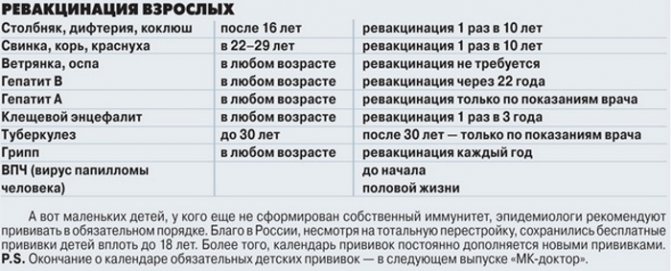
But having experienced diphtheria and tetanus does not guarantee that a person will not get sick with them again. Vaccinations do not provide such protection against diseases. But the developed anti-diphtheria and anti-tetanus antibodies through vaccination protect the human body from the penetration of pathogens.
Therefore, these diseases either do not have time to develop, or will occur in a mild form, without causing complications.
The duration of action of vaccinations is directly related to the age at which a person was vaccinated:
- Children of the 1st year of life receive 3 vaccinations against diphtheria and tetanus (at 3 months, 4.5 months and six months) with a break between them of at least 45 days.
- At 1.6 years old, the 1st revaccination is given.
- 6-7 years – 2nd revaccination.
- 14 years – 3rd revaccination.
- For children over 18 years of age and adults, revaccination is done every 10 years from the date of the previous vaccination.
The history of the discovery of a method for preventing anaphylactic shock
On January 10, 1907, in Paris, microbiologist Alexander Mikhailovich Bezredka, who worked in Mechnikov’s laboratory, announced that he had discovered a method for preventing anaphylactic shock. It seemed to Mechnikov that this brilliant discovery would help prevent the premature onset of old age. Mechnikov decided to share his idea with his longtime opponent, writer Leo Tolstoy.
Anaphylaxis translated from Greek means “reverse protection.” This disease is caused by one's own antibodies, designed to protect the body, but instead causing harm to it. After exposure to even a small amount of a foreign antigen (this phenomenon was first noticed in 1902 during treatment with anti-diphtheria serum), antibodies are produced against it, and a lot is more than enough. They lie in wait for new antigen particles. Like operatives in an ambush, they scatter through the nooks and crannies of the body and strengthen themselves on the walls of the capillaries. It takes 10-12 days to organize such an “ambush”. In guinea pigs it is placed for 3 months. In a person, perhaps for life.
When the same antigen enters the blood with a new injection of serum, antibodies retain it. The trouble is that with “one hand” they grab the enemy, and with the “other” they hold on to healthy tissue cells. The products of the fight between antigen and antibody affect these cells, which release “alarm signals” - histamine, serotonin and others. The vessels dilate, the pressure drops sharply, and swelling begins. Bezredka watched as a guinea pig fell on its side in convulsions and died from paralysis of the respiratory center. He called this phenomenon “anaphylactic shock.” Unfortunately, it causes almost every hundredth death in hospitals and is heard far beyond the circle of specialists.
At first the doctors were confused. To figure out how to avoid shock, you first had to imagine at least the analogy outlined above. It is no coincidence that it came to Bezredka’s mind. He studied a similar topic at the Pasteur Institute, where Mechnikov invited him.
Bezredka was born in 1870 in Odessa and studied chemistry at the university there. Under the influence of Mechnikov, a teacher and family friend, he became interested in medicine. But he could not enter medical school, because during his youth they tried not to admit people of the Jewish faith. Fortunately, it was then that Mechnikov moved to Pasteur and promised to take Bezredka to him if he graduated from the medical faculty of the Sorbonne. Since 1893, Alexander studied in Paris, while simultaneously working as a preparator for Mechnikov.
Mechnikov, in his own words, “a zoologist lost in medicine,” needed assistant doctors. As an erudite scientific director, he himself was a treasure. Bezredka and his colleagues called it “a walking bibliography” behind their backs. They were ready to go through thick and thin for their leader, especially since he did not stop them from working creatively.
The most pressing problems in Paris at the turn of the century were syphilis and typhoid fever. Pasteur believed that a vaccine made from living but weakened pathogens should help against them. Bezredka decided to expose the typhoid bacillus to the attack of antibodies. When they cling to the microbe from different sides, like dogs cling to a bear, it is not so active. It can be introduced into the body to train the immune system to fight it.
While they were busy with typhus, a new scourge arose - anaphylaxis. Those who managed to survive it are not subjected to it again. A guinea pig that withstood two injections of serum into the peritoneum calmly tolerated a lethal dose of the allergen. Probably, after the shock, the antibodies that caused the reaction run out. It cannot be, Bezredka thought, that there could have been no central nervous system. He began to make both the first and second injections directly into the brain. The shock killed 24 of the 31 pigs, as expected. But an injection into the peritoneum made the animals insensitive to the brain injection. Moreover, there was no reaction if not 12 days, but an hour and a half passed between injections.
This was the first victory. Bezredka reported about it on January 10, 1907, and proposed testing this method: first, a small dose is administered to a serum-sensitive pig, and after an hour and a half, the main dose is administered. But then the Pasteur Institute ran out of experimental guinea pigs. New ones were found through friends at the Health Board of New York, and then Bezredka managed the experiment by telegraph.
His analogy worked. So, there is an ambush in the capillaries, antibodies are dispersed there. If you immediately introduce a large dose of antigen, the fight against it will begin over the entire area of the vessels. But a small dose will gather the majority of the antibodies: they jump out of their nooks and crannies and rush at strangers from everywhere. This is how Bezredka understood it. He also suspected that if the central nervous system was turned off, the alarm would not be raised even in the event of a large invasion. Indeed, it turned out that anaphylactic shock does not occur under anesthesia (1 case per 15 thousand patients).
The discovery made in Mechnikov’s laboratory convinced the Nobel Committee that it was time to reward the creator of the doctrine with immunity. In Stockholm, laureate Mechnikov accidentally learned that the prize for literature was going to be awarded to Tolstoy, but the secretary of the committee rejected the nomination because he did not like the religious teachings of Lev Nikolaevich. Mechnikov saw this as a reason to meet with Tolstoy, and asked to visit the great writer.
While he was traveling to Russia, Lev Nikolaevich sat down to read books to maintain a conversation with the great scientist. But they seemed to communicate in different languages. Mechnikov argued that a person should live 120-150 years, but ages ahead of time due to self-poisoning of the body. In modern terms, old age is an autoimmune process. But if you introduce a small dose of the “poison of old age,” the body will be desensitized and remain in good shape until the person himself is fed up with life. Tolstoy replied that there is no point in prolonging life while evil triumphs in the world. “The grief is not that we live for a short time, but that we live poorly, we live against ourselves and our conscience.”
Lev Nikolaevich did not want to turn a meeting with a great man into a banal dispute between an atheist and a believer. There was a piano in the house, and pianist Alexander Goldenweiser was a guest. He was on a roll that evening. We listened to Chopin, whom Mechnikov and Tolstoy both loved. They cried a little, cursed Scriabin and “all these current ones.” We parted on friendly terms and then even exchanged a couple of letters.
In this dispute, Bezredka was at first on Mechnikov’s side. A scientist improves life on Earth and must do science. As Chekhov said, “there is more love for a person in electricity and steam than in chastity and abstinence from meat.” Bezredka demonstrated this brilliantly at the front, where he was called up as a naturalized French citizen. First, as a paramedic on a medical train, and then, having sorted it out, as the chief microbiologist of the Verdun fortress. He taught military doctors his method of preventing shock from injection of tetanus serum. The method still bears the name Bezredki. Already in that war he saved thousands of lives.
Having been demobilized, Bezredka headed the laboratory of his teacher, who died in 1916. Paris was flooded with Russian emigrants, and Alexander Mikhailovich found help and work for many learned compatriots. He considered it part of doing science. When Soviet doctors, veterinarians and microbiologists began to come to Europe for internships, three-quarters of them worked at least a little with Bezredka. Seeing how he sympathized with his people, they - some by conviction, and some by instruction - offered him to help the cause of the Comintern in France. Bezredka made the excuse that he was French only by passport, and had no moral right to interfere in public life.
And there was no desire to break away from science. Bezredka discovered that sarcomas of various types are preceded by a viral infection. The idea arose to make a vaccine against viruses or poison cancer cells with toxins from specially “trained” microorganisms. It turned out that microbes and parasites can stop the development of a malignant tumor. The malarial plasmodium was especially distinguished.
And I still had to be distracted from these ideas by social life. Helping emigrant employees, Bezredka formally joined the presidium of an organization called the Jewish Health Society (OZE). It was founded in St. Petersburg in 1912 and was engaged in the prevention of diseases of children from Jewish families of various incomes: vaccinations, summer camps, medical examinations, and so on. There were OZE branches throughout the empire. Finding themselves outside Soviet Russia, members in the Baltic states, Poland, Romania, Finland and Western Europe formed the UNION-OZE, headquartered in Berlin. Albert Einstein became the honorary head of the union. After the Nazis came to power, the headquarters moved to Paris, and Bezredka took Einstein's place.
Their correspondence has been preserved. In his first message, in 1930, Alexander Mikhailovich asked the great physicist to organize a fundraiser. Einstein arranged a concert with pianist Arthur Schnabel, at which he himself played the violin, almost the only time in public. The second letter, written in 1935, was sent by Bezredka, already as the head of the Union, to Einstein in Princeton. It tells about 62 German emigrants who were settled in the Soviet Union.
Bezredka's office at the Pasteur Institute became the meeting room of the Union. Every day the situation worsened, and it was necessary to act. In the spring of 1937, Bezredka was part of a delegation of French doctors that visited Moscow to visit his charges. He had not been to his homeland for 45 years. A newspaper review of the trip was written by the most enthusiastic. Moscow has a beautiful metro, where the buffets sell delicious cakes. People are dressed well, the Soviet microbiologists with whom he was visiting live in separate apartments, and their laboratory has “a more than sufficient budget.” But in reality, many refugees from Germany have already disappeared. The Bolshevik venereologist Wolf Bronner, who accompanied the delegation, was soon arrested as a French spy and shot. The USSR was clearly not suitable as a refuge.
In Central Europe, the Union went illegal. After the Kristallnacht pogroms, Jewish children were taken across the border from Germany and Czechoslovakia with false documents. To house them, OSE rented castles in the south of France, away from the German border.
Bezredka was very worried that now, when he is not 70 and is full of valuable ideas regarding the fight against cancer, he has to engage in smuggling. In the summer of 1939, he fell into depression, fell ill and was forced to undergo treatment at a resort.
Having barely recovered, the German army captured Poland. From there came messages one more terrible than the other. France and Britain formally declared war on Hitler, their armies crossed the German border - and stopped. Alexander Mikhailovich refused to understand this. Why won’t the forces of good with superiority in people and technology stop the nightmare in eastern Europe?
On February 28, 1940, Bezredka died of a heart attack. He did not see the defeat of France and did not witness the catastrophe of his people. Hundreds of children passed through the appearances arranged by the Union. Many survived: the younger ones were transported to America and Switzerland, the older ones joined the ranks of the Resistance.

